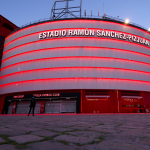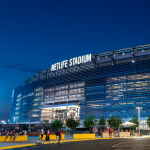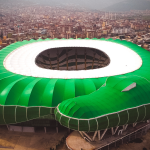
History and aesthetic of Ramón Sánchez-Pizjuán
"La Bombonera de Nervión"
May 11th, 2023
Football has so many clichés. In one of them, fans can become the twelfth man on the pitch for a team. Coaches relentlessly use this catchphrase to captivate the fans so that they can become a key factor during the 90 minutes. It is also the most rhetorical image used by journalists to describe unceremoniously a stadium packed. The problem with this stereotype is that it cannot be applied to every ground. There are stadiums and stadiums. In certain grounds the enthusiasm and the excitement that you breathe at the kick-off slowly fade away before being eventually deleted from the equation of a match. Then, there are grounds where it’s undeniable that fans can be crucial. It’s not only a matter of how much passionate a fanbase can be. To all of that, it must be added architectonical elements: the layout of the stands, where they’re located and how they’re perceived by the players on the pitch. If there’s no separation from the pitch and the stands, if opposing players must face a wall of fans all dressed in the same color ready to sing with one voice for their them, then yes: a stadium can become a factor.
This final preamble applies perfectly to Sevilla’s stadium Ramón Sánchez-Pizjuán, a washbowl of 43000 seats with stands overhanging the pitch. Few grounds can deliver passion and be intimidating like the Pizjuán on European nights: the latest example came during the second leg of Europa League’s quarterfinal when Sevilla colored all the stands in white before the kick-off and then pushed José Luis Mendilibar’s team to a 3-0 victory over Manchester United. That night, the Pizjuán has confirmed itself as the most South American among European stadiums, creating the optical illusion of a stadium ready to collapse on the pitch after every goal. The most natural term of comparison is La Doce, Boca Juniors’ ultras sector who turns into a human avalanche after every goal that only fences prevent to collapse on the pitch. And it is no coincidence that one of the nicknames for the Ramón Sánchez-Pizjuán is “La Bombonera de Nervión”, a reference to Buenos Aires’ La Bombonera, home of the Boca Juniors.
The mastermind behind the project has been Manuel Muñoz Monasterio, the architect who designed Real Madrid’s Santiago Bernabeu. He won in 1954 the competition for design and edifying the new Sevilla’s stadium. When it opened in 1958, the ground was named after Ramón Sánchez-Pizjuán, the president of the club back then who fought hard to give the fans a new home but passed away two years prior its opening. Since the inaugurations there have been many renovations: the latter started in 2015 with the external structure has been fully covered with red leds creating a marvelous visual effect, warming up the atmosphere on European nights or when the derby against Betis is played under floodlights. A touch of modernity for a ground and a club extremely tied with its traditions.
Every gate is dedicated to a team legend and the number 16 is the most special one as it is dedicated to the memory of Antonio Puerta, the player who died in 2007 after several heart attacks with the first came on Pizjuán’s pitch while playing against Getafe. The same fate happened to Pedro Berruezo in 1973, another club’s legend to whom it has been dedicated the gate 10. The last twist of magic comes from Santiago del Campo’s mosaic, realized in 1982 for the World Cup played in Spain. It is an absolute work of art, something you don’t normally cross on a football ground. It represents the Sevilla’s logo alongside the badge of other European teams. It has been located at the Gate 1, the main entrance, to remember everyone that the Ramón Sánchez-Pizjuán is not your average stadium. It’s a place where beauty meets passion and becomes the twelfth man on the pitch.


















